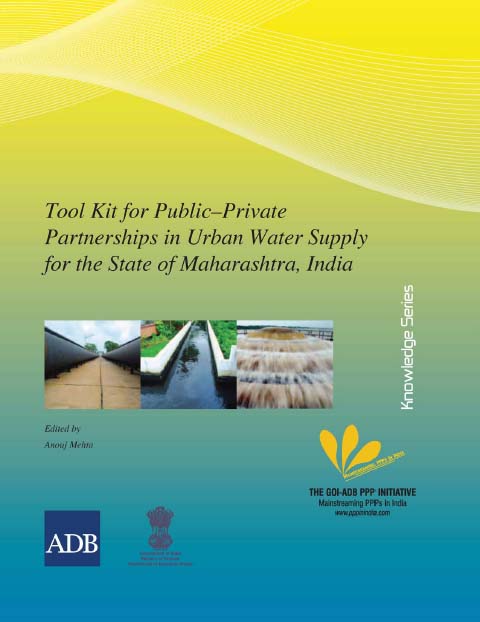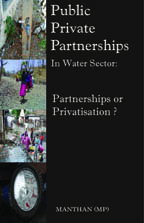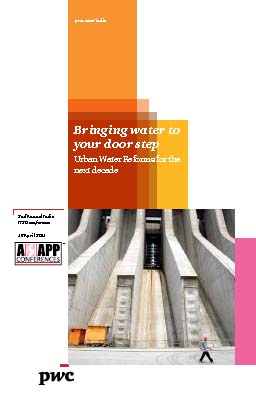
The word privatisation is derived from the latin word “privatus”. Privatisation of water services means transfer of ownership, property or the business of water services from the government to the private sector. This includes services such as operation and maintenance of water services, bill collection, metering, revenue collection, etc.
Water: Commons or a commodity?
Water is a basic need of life and even the United Nations (UN) has recognized this need as a human right. The UN World Water Report of 2006 notes that "there is enough water for everyone" and "water insufficiency is often due to mismanagement, corruption, lack of appropriate institutions, bureaucratic inertia and a shortage of investment in both human capacity and physical infrastructure".
However, the process whereby all resources not limited to water are transformed from a public good to a tradable commodity is due to economic processes at work. Fears over water scarcity and the need to manage water efficiently by giving it an economic value is the starting point from where privatization is pushed. Critics of public supply of water insisted on the state’s inability to operate efficiently and created a case for a shift towards market-based water governance. However, “when private companies try to make large profits through high water prices, it denies the poor the inalienable right to the most necessary substance for life”, says Vandana Shiva, noted environmentalist.
Yet worldwide, there is a rush to privatize water services.
Myths of privatization
There are several myths associated with the concept of privatisation, the most popular being:
- Privatisation saves money.
- Private company does a better job than those in the public sector.
- Privatisation will lead to lower prices and better standards of service.
- Turning the public utilities into private companies results in a dramatic improvement in their performance and efficiency.
- Privatization needs to be accompanied by minimal regulation.
- Privatization allows governmental entities to better anticipate and control budgetary costs.
- Privatization allows governmental entities more administrative flexibility.
- The public still maintains control over a privatized asset or service and the government retains the ultimate ability to make related public policy decisions.
- If anything goes wrong, the government can easily fire the contractor or adjust the contract.
- Companies are chosen for privatization contracts on the merits, not based on political or financial connections.
(Sources: Exposing the myths of privatization, Privatization myths debunked)
Background of water privatization: International experience
The water privatisation wave started in the early 1990s in Latin America and then it spread to other developing countries across the globe. The rapid thrust in water privatization in developing countries was due to increased involvement of the World Bank and International Monetary Fund (IMF) in pushing structural reforms with governments to facilitate private sector growth. Lending terms were imposed on developing nations through stipulations in trade agreements and loan conditions to impose water privatization. The water sector was sought to be opened through the World Trade Organisation (WTO) and General Agreement on Trade in Services (GATS) that are a set of rules governing international trade.
Divesting the water sector of social obligations
The provision of the resource was increasingly vested in the hands of a few multinationals mostly European and American, with the top two multinationals controlling about 75% of the water industry. The sector is a natural monopoly owing to the high levels of investments and extensive distribution networks required. These big multinationals were able to exert strong pressure on national governments to privatize water provisioning. An attempt was made to recover the full price of water provisioning, and cross-subsidies were removed to ensure free market trade. Although pro-privatization proponents claim that it has a great record of accomplishment of success with regards to increase in efficiency, quality, reliability and affordability of services to the people, in reality, privatisation programs are structured in a manner where the risks are passed on to the public and no major investments are made by the private company without a ‘take or pay’ clause.
Impact of privatisation
Across the globe people resisted privatisation of water services due to its serious impact on the poor. "In Australia, in 1998, the water in Sydney, was contaminated with high levels of giardia and cryptosporidium shortly after its water was overtaken by Suez Lyonnaise des Eaux… In Britain, Water and sewage bills increased 67 percent between 1989 and 1995. The rate at which people's services were disconnected rose by 177 percent… Water rates in England increased by 450 percent while company profits soared by 692 percent. CEO salaries for the private corporations behind the water supply increased by an astonishing 708 percent. As one can expect with such high price fixing, service disconnection increased by 50 percent. Meanwhile, the British Medical Association condemned water privatization for its health effects because dysentery increased six-fold. After privatization, water fees in France rose by 150 percent while the water quality declined.” (Water is life)
The anti privatization protest has started gaining popularity after the water privatisation conflict in Cochabamba, Bolivia in 2000. The model of privatisation advocated by the World Bank has started failing in many countries like Buenos Aires, Tucuman (Argentina), Dar es Salaam (Tanzania), Grenoble (France), Metro Manila (Philippines), Nkonkobe (South Africa), Atlanta (USA),etc. In South Africa, this has led to thousands of disconnections (from water supply) for those who cannot pay. Commentators fear that this has affected the health of the nation’s people and decreased social equality further. (Water, Private Limited, Manthan Adhyayan Kendra)
The case of Cochabamba and El Alto in Bolivia
Cochabamba, the city of the now famous ‘water wars’ in Bolivia is the most well known example of the conflict over privatization of its municipal water supply utility (to Bechtel, a US based Corporation) at the behest of the World Bank. Many people were forced to literally choose between food and water leading to a peoples uprising in 2003 to oppose the concession.
In El Alto, Suez got several concessions including an assured rate of return and soft loans but yet, hiked connection charges steeply. The monthly water bill rose to $20 in a city where the minimum wage is less than $100 a month the moment Aguas del Illimani (AISA), a subsidiary of Suez, a water giant took over the water services. The government was forced to revoke its water privatization legislation soon after people protested.
Elements of the water privatisation process
The process of privatisation of water services entails:
- Unbundling (separation of source, ‘transmission’ and ‘distribution’)
- Independent regulator to free the sector from ‘political interference’, to set tariffs and decide other issues
- Steeply increasing tariffs, de-politicisation of tariffs
- Full cost recovery
- Elimination of subsidies
- Cutting off supplies for non-payment
- Dismantling public/ community supplies like public taps, stand posts
- Retrenchment
- Privatisation and Public-Private Partnerships
- Allocation of water to highest value use through market mechanism
- Water entitlements being introduced for ensuring markets of tradable water rights
- New laws to enshrine and ensure all this
(Source: Water, Private Limited, Manthan Adhyayan Kendra)
Modes of privatisation
Privatisation of Water Supply and Sanitation (WSS) can be several levels and can be of various types. It may involve components from the dam, canal system, water treatment plant, water distribution system, billing system, collection/ treatment/ disposal of wastewater and sewage.
- Service Contracts: These are short-term contracts for providing particular services like meter reading and bill preparation.
- Lease/Management Contract: The ownership of the water facility remains with the municipal authority and the company is appointed by it to manage the facility or the facility is leased out to the company. The municipal authority does new investments and expansion while the company has to manage the day-to-day operations.
- Build Own Operate Transfer (BOOT) Contracts: The company builds a part of the infrastructure (treatment plant, filtration plant etc) and runs it under a long-term contract, with a purchase agreement that has ‘take-or-pay’ guarantee clauses.
- Concessions: These are long term contracts wherein the private company takes full responsibility of the system, provides services and is responsible for expansion, new investments, recovery of bills etc.
- Divestures: In this case, the Government either fully or partially divests its equity in a utility that is then bought off by a private company.
Water privatisation in India
Water privatization in India started in the late 1990s. The government with the technical assistance of International Financial Institutions like the World Bank and the Asian Development Bank developed water policies and various laws to facilitate private sector participation in the water sector. The entire paradigm of the water sector is seeing modifications manifesting in changes in water policies, laws and institutions. Manthan Adhyayan Kendra describes the happenings in the water sector as "not merely privatisation, but more accurately corporatisation or corporate globalisation (since most of the companies involved are foreign multinationals)".
“The Borai Industrial Estate Build Own Transfer (BOT) Water Supply project on the Sheonath river in Chhattisgarh, the proposed private sector management contracts for several zones in Delhi, proposed privatisation of water services in Bangalore under Greater Bangalore Water Supply and Sewerage Project (GBWASP), the Maheshwar Hydro Power Project on Narmada in Madhya Pradesh, the Coca Cola factory in Plachimada, Kerala exploiting public groundwater to manufacture soft drinks – all are examples of the rapidly growing privatisation of water services and resources in India. As these examples show, privatisation in the water sector involves all elements – hydropower, industrial and domestic water supply, and even irrigation.” (Water, Private Limited, Manthan Adhyayan Kendra)
India has witnessed the violation of standards of operation by private companies who indulge in price fixing and amplify prices after they take over. It is the poor who face disconnections and are often forced to drink contaminated water, consequently.
The Sheonath river project in Chhattisgarh was one of the initial water privatisation projects in India. Thousands of people protested against the government;s decision to hand over 23 kms of the river to private companies and the banning of the locals from using the river water. In this case, privatisation was not limited to the water service but extended to the river itself.
In the last two decades, there has been a massive increase in private sector participation projects in the water sector in various cities across India. Most of the major private sector players like Suez, Vivendi, Thames Water and Bechtel are present in India. The state wise list of private sector participation projects is available on Manthan’s web site, an organization involved in the public scrutiny of water privatization projects.
To know more about the myths and the reality related to the privatisation of water services in New Delhi please see the report titled: Privatisation of water services in New Delhi : Myth and reality - Report by Water Privatisation - Commercialization Resistance Committee.
Aid agencies like Department for International Development (DFID), AusAID and USAID are pushing for privatisation of projects initiatives. The centrally sponsored Jawaharlal Nehru National Urban Renewal Mission (JNNURM) has through Municipal Reforms Projects in states made it mandatory for municipal corporations to undertake mandatory urban reforms, including possible privatisation of water, in order to be eligible for central funds. The irrigation sector too is seeing greater involvement of the private sector in canal operations and comprehensive privatisation of select schemes often in the name of Participatory Irrigation Management (PIM). Concepts like tradable water entitlements and tradable pollution permits are likely to lead to the cornering of water resources by those who have the purchasing power or who can buy the right to pollute.
Manthan's website has a database of water supply, sanitation and hydropower projects involving privatisation in India.
The way out
Because private sector focuses on profit it is important that Government’s restructure Water Utilities to reverse the infrastructural decay and improve their performance. There is a need to have greater engagement with the public and make Water Utilities accountable and capable of delivering water services.
References
- Green Left Weekly
- Exposing the myths of privatization
- Privatization Myths Debunked
- Running Dry: the humanitarian impact of the global water crisis
- Water Privatization Case Study: Cochabamba, Bolivia
- Shiva, Vandana. 2002. Water Wars: Privatization, Pollution, and Profit. South End Press. 158 pgs.
- Water: Private, Limited, Issues in Privatisation, Corporatization and Commercialization of Water Sector in India, Gaurav Dwivedi, Rehmat and Shripad Dharmadhikary, Manthan Adhyayan Kendra, Badwani, 2007










 This report by
This report by